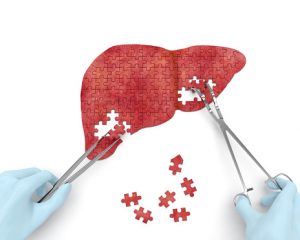 Chronic liver disease is a condition that is commonly associated with those who drink an excessive amount of alcohol, leading to damage of hepatic cells. However, there is a similar condition involving the liver called non-alcoholic fatty liver disease (NAFLD), which, as the name suggests, does not stem from alcoholism. This has puzzled scientists for decades, as no cause of the condition has been identified. Nevertheless, an international study from the UT Southwestern Medical Center may have come one step closer to finding a cause, identifying a striking genetic-environment interaction in the development of non-alcoholic fatty liver disease.
Chronic liver disease is a condition that is commonly associated with those who drink an excessive amount of alcohol, leading to damage of hepatic cells. However, there is a similar condition involving the liver called non-alcoholic fatty liver disease (NAFLD), which, as the name suggests, does not stem from alcoholism. This has puzzled scientists for decades, as no cause of the condition has been identified. Nevertheless, an international study from the UT Southwestern Medical Center may have come one step closer to finding a cause, identifying a striking genetic-environment interaction in the development of non-alcoholic fatty liver disease.
NAFLD is a condition where the liver is subjected to excessive fat accumulation. It is becoming an increasingly prevalent problem in the United States and has become the most common form of chronic liver disease, with and estimated three to twelve percent of American adults having a more serious form of NAFLD called non-alcoholic steatohepatitis (NASH), which can progress to liver cancer. The reasons for its occurrence are not well understood but are thought to be due to various metabolic conditions such as obesity, insulin resistance, hyperglycemia, and high-fat levels in the blood. Initial symptoms of NAFLD include:
- Enlarged liver
- Fatigue
- Pain in the upper right abdomen
Advertisement
NASH symptoms include:
- Ascites – abdominal swelling
- Enlarged blood vessels
- Breast development in men
- Enlarged spleen
- Red palms
- Jaundice – yellowing of the skin
Researchers found that obesity amplified the effect of three gene variants that increase the risk of NAFLD by different metabolic pathways. Of the three, a gene named PNPLA3 was found to have the strongest genetic-environmental interaction and it is the first genetic cause of NAFLD ever identified. This achievement was possible through a longitudinal, multi-ethnic, population-based study that included 384 subjects with cirrhosis. Their analysis showed the risk of developing cirrhosis among those with two copies of the PNAPLA3 gene who were also obese increased 5.8 times compared to those who were obese but lacked the genes in question.
“While all obese individuals who have fatty liver disease would benefit from weight loss, our data suggest that those who have the risk allele in PNPLA3 are likely to benefit more,” said Dr. Hobbs, director of the McDermott Center.
The researchers observed individuals who were either lean or obese and also looked at whether they carried the PNAPLA3 gene or not. They say that the prevalence of fat buildup ranged from nine percent in lean individuals who did not have the particular gene to 84 percent of fat buildup in obese individuals who had two copies of the gene in question—one from each parent.
“If you are thin, then you are unlikely to have excess fat in your liver even if you have the PNPLA3 risk alleles. On the other hand, if you are obese and lack the variant, then there is a good chance that you won’t have excess fat in your liver,” said Dr. Cohen of the Center for Human Nutrition and the McDermott Center.
